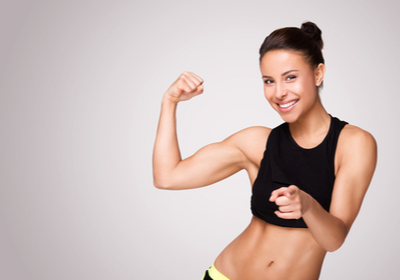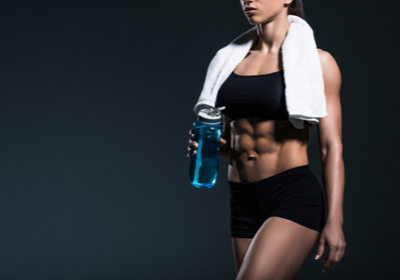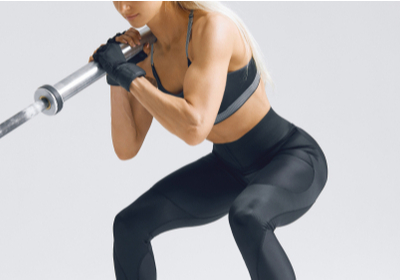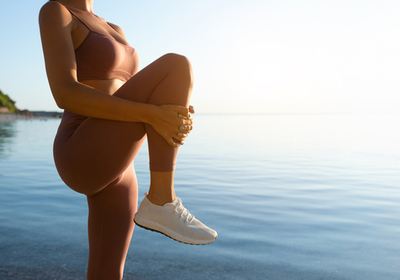VIDEO
Plate Side Lunge, Squat Knee To Elbow, Frog Squats, Plate Over Head Squats
- Core
- Biceps
- Triceps
- Upper Back
- Gluteus
- Quads
- Hamstrings
- Thighs
Level:Intermediate
Trainer:
Equipment:No Equipment
Plate Side Lunge, Squat Knee To Elbow, Frog Squats, Plate Over Head Squats
- Core
- Biceps
- Triceps
- Upper Back
- Gluteus
- Quads
- Hamstrings
- Thighs
Level:Intermediate
Trainer:
Equipment:No Equipment
1. Stand straight with your feet hip-width apart. Make a step out to the side trAbsfering your weight to that leg. Using your lead foot push yourself back to the starting position. 2. Coming into a squat, engage your core. Stand and lift your left knee into your right elbow. 3. Stand with your feet wider that shoulder-width apart. Bend your knees and pushing your hips back get into a squat. Squat down until your Thighs are parallel to the ground and your fingers can touch the floor.
save to ...
RECOMMENDED FOR YOU
- Core
- Arms
- Legs
Duaration: 00:15
save to playlist
- Core
- Arms
- Back
Duaration: 00:15
save to playlist
- Core
- Legs
- Gluteus
Duaration: 00:15
save to playlist
- Core
- Arms
- Back
Duaration: 00:15
save to playlist
- Legs
- Gluteus
- Hips
Duaration: 00:15
save to playlist
- Core
- Arms
- Legs
Duaration: 00:15
save to playlist
- Abs
- Lower Back
- Gluteus
Duaration: 00:15
save to playlist
- Core
- Legs
- Gluteus
Duaration: 00:15
save to playlist
- Core
- Arms
- Legs
Duaration: 00:15
save to playlist
Blog
Relief of the biceps is one of the main goals of everybody who does sports and works on their body. At the same time, it’s pretty hard to develop these muscles because of a wide variety of reasons. In this article, we’ll talk about biceps and how to develop these muscles. So let us dive in.
What Is Biceps?
The biceps is the muscle of the upper arm that consists of two parts, which are the long head and the short head. The muscle is connected to the bone with the proximal biceps tendons in the shoulder joint and the distal biceps tendons in the elbow joint. To put it simply, the biceps is a big muscle that is situated in the upper arm from the shoulder to the forearm. The main function of the biceps is to extend and flex the arm at the elbow. It also helps rotate the forearm and hand. So basically, this muscle allows us to lift objects, hold heavy things, and do many other daily things.
Tips on How to Grow Biceps?
Certainly, everybody dreams of relief biceps muscles, but achieving this goal is not that easy. In fact, except for working out, you need to do a lot of other stuff to grow biceps muscles. So here are some tips and tricks on how to grow biceps fast and stress-free:
Eat more protein. For building any muscle, our body needs amino acids and the best way to get them is to eat more protein.
Exercise regularly. In order to succeed in any area, you need to practice regularly. The same goes for developing bicep muscles - you need to work out regularly.
Consider having your thyroid checked. If you eat protein and exercise but you still see no progress, you might want to visit a doctor and have your thyroid checked because there might be some hormonal issue.
Don’t be upset if you don’t see immediate results. Growing biceps takes quite a lot of time, so don’t be upset if after a few weeks of training you see no result. Just continue moving towards your goal, and soon, you’ll reach it.
Make sure you do the right workouts. Not all arm workouts are aimed at the biceps, so you have to ensure you do the right exercises. If you have any doubts, you can always consult your personal trainer or check out this information on the internet.
These simple tips will help you reach your goal faster, so make sure to use them.
Best Workouts Biceps
To wrap up, we would like to provide you with some basic biceps workouts. So without any further ado, here they come:
Barbell curl
Standing dumbbell curl
Cable curl
Zottman curl
Chin-up
Barbell bent-over row
Reverse-grip bent-over row
Underhand seated row
EZ-bar preacher curl
Twisting dumbbell curl
Cable hammer curl
Inverted row
Hammer curl
Meadows row
Concentration curl
Seated cable row
Incline dumbbell curl
Final Thoughts
Gorgeous relief biceps is a dream come true for many men and women. But why dream of it if you can make it real? Explore the biceps workouts in the video section and make your dream of having developed biceps come true.
Read more
СWorking on the core muscles is not only essential for good looks, but also for your health. In this article, we will talk about core muscles and how to develop them. So without any further ado, let us begin.
Core Muscles: What Do They Consist of?
To put it simply, core muscles consist of two main groups, which are central and peripheral. The central muscles resemble a sac that protects internal organs by covering the abdominal cavity. In other words, we need these muscles to keep the vital organs safe. In fact, if we didn’t have these muscles, a slight kick in the abdominal area would cause significant damage to vital organs. Central muscles can be divided into several parts, which are:
Front - abs
Lateral parts - oblique muscles and the surrounding muscles
Back - the muscles that support the spine
Upper wall - diaphragm
Lower wall - pelvic floor muscles
The second group of core muscles, the peripheral muscle group, consists of the trapezius, the latissimus dorsi muscle, the pectoralis muscle, the buttocks, and the muscles of the shoulder girdle. These muscles are essential for our posture and back health, which means that developing those is rather important for everyone who wants to be healthy and look beautiful.
Both central and peripheral core muscle groups are extremely significant for our health, posture, as well as the way we look. Therefore, in the next paragraph, we are going to talk about the best exercises for strengthening these muscles.
Best Workouts for Strengthening Core Muscles
So we made it pretty clear that developing core muscles is important for pretty much everyone. So what exercises can you do to strengthen these muscles? Well, here they come:
High plank
Supine toe tap
Hollowman
Bird Dog
Crunches
Bicycle crunch
Superman
Warrior crunch
Supine leg lifts
Elbow to knee
Bridge
Mountain climber
V-sit
V-ups
Side plank
Plank shoulder taps
Turkish get-up
Elbow plank twists
As you can see, there are many workouts that will no doubt help you develop core muscles and eventually become healthy and fit. So why don’t you grab your fitness mat and try at least some of these useful exercises to see their effectiveness yourself?
Wrapping Up
Not only are core muscles essential for beautiful abs, but also rather important for your back health and posture. Furthermore, these muscles protect your internal organs, which is a pretty important feature. Therefore, if you regularly train but you always avoid core exercises thinking they are not as important as the workouts for your legs or arms, you better stop doing that because core muscles are perhaps the most important muscle group in your body.
Read more
The quadriceps is a large and strong muscle that acts as the primary extensor of the knee joint. Because the knee joint carries most of the body's weight, the quadriceps is the main muscle of the lower thigh. Weakness of this muscle, in fact, would simply make it impossible for people to maintain an upright posture. Quads are made up of the four coronary muscles: the straight, inner, outer, and middle muscles. In spite of this, during various exercises, the load falls completely on this muscle. Sure, strengthening your quads is important, so let's give a quick look at a few of the best exercises for them.
Barbell and Dumbbell Lunging
You can do lunges in many different ways. You can do this either with a barbell, or dumbbells, while walking around the gym, or from a stand-up position. Let's consider a variation where the athlete stands in a position using a barbell or dumbbell. This position is similar to the squat position with a barbell on your back. Take a step forward with your right foot. The lunge should make the thigh of the working leg to be parallel to the ground at the low point. Simultaneously, the knee of the left leg almost touches the floor, also forming a 90-degree angle. Back to the previous position. Change legs - take a step forward with your left leg.
Leg Press
The leg press takes as much of the work out of your back and hips as possible. At the same time, it allows you to train with a much heavier weight than a deep squat. In order to place the load on your quads, your feet should be shoulder-width apart while doing the leg press.
Just follow the right workout technique. Press your back and head firmly against the bench, with your legs almost completely straight and resting on the frame and your hands firmly gripping the handles. Bending the knees, form a straight angle between the thighs and calves. Lower the legs back to the previous position.
Single-Leg Squat
Make single-leg squats if you can't go to the gym to train with training machines. It is a perfect way to get your quads workout done. Because it allows you to load your legs without using extra weight. Start in a standing position, extending one leg slightly forward. While squatting down, extend the leg forward and straighten it. Get back to the previous position. Repeat at least 10 times for each leg.
Kick Squat
Standing with feet shoulder-width apart and toes slightly to the side, place your hands at your waist or cradle them in front of your chest. Focus on the center of your feet. Squat down horizontally at the hips, remembering to keep your back straight. Stand up shifting your weight to one side. Lift your knee to a horizontal position and make a kick with your foot. The kick should be done in one movement.
Squats With Fitness Ball
Position your feet a little wider than shoulder-width apart with your toes out to the sides at a 45-degree angle. Grasp the fitness ball, keeping a tense and natural bend at the waist, straight shoulders, and neck. Holding the exercise ball, raise your arms up to shoulder height. As you inhale, begin to bend your knees to your sides, making sure they don't stick out past your toes. Your hips should go down first. Your weight is on your heels. Bring your back slightly forward as you squat down and extend your arms to lift the exercise ball over your head. Perform 30-50 repetitions.
Final Thoughts
Every person dreams of having beautiful legs, and luckily, getting great quads isn't that hard if you know what to do. So why don't you try these exercises?
Read more
The Kardashians have created many beauty trends, one of which is having beautiful buttocks. So, in this article, we'll talk about building great gluteus muscles so you can look as attractive as Kim, Kourtney, and Khloe. Let's begin by looking at the anatomy. The glutes are made up of three main parts.
The gluteal maximum muscles, which are the largest muscles in the body, help to maintain balance when walking and running. They allow your legs to move sideways and are also responsible for contouring the shape of the buttocks.
The gluteus medius is overlaid in part by the gluteus maximus and is located at the top of the pelvis. It is involved in leg extension, lateral flexion, and body stabilization during the movement.
Finally, below is the gluteus minimus. Both are in charge of leg induction and body stabilization, as well as shaping the thigh line.
Training for the glutes
Building your glute muscles isn't easy, particularly when you're on a tight schedule. However, by working out at least three times a week and never giving up, you will quickly reach your goal. To help you achieve your goals, we've compiled the best exercises for your gluteus muscle development.
Deep squat with a barbell
This is one of the basic exercises that help to develop this muscle effectively. From the starting position - with your feet apart - lower your pelvis below the knees. Keep your lower back straight and make sure the knees do not go over your feet. Spreading your legs wider apart puts more pressure on your hips.
Romanian deadlifts
Stand up straight with a slight bend at the waist. Holding the dumbbells in both hands, bend over and pull your pelvis backward. Reaching a point just below your knees, return to start.
Dumbbell split squat
Exercise with a straight back and one leg stepping forward while the other leg is thrown into a brace behind you. Squat down and perform the exercise with both legs.
Back lunges
From the standing position, take a large step backward and drop down to form a bent-over position. Return to start and repeat this exercise for the other leg. Make sure your knee is bent at a right angle and not sticking out past your toes, do 20-30 reps. It is important to step backward precisely, maintaining rhythm and balance.
Having great gluteus is everyone's dream, and luckily, developing these muscles isn't difficult if you know the right exercises. So why not take advantage of our tips and start working towards your goal right now?
Read more
People often underestimate hamstrings. Often, focusing on training the quadriceps and calves, hamstrings seem less important. However, you should remember that neglecting any muscle has aesthetic and medical consequences that can be avoided if you work it properly. The reason you shouldn't ignore these muscles is not just about the symmetry and appearance of your body. Hamstring weakness is one of the most common causes of injury in most professional athletes.
The best way to strengthen your leg muscles is to work them out properly. So let's have a look at the exercises.
Barbell 90
The main advantage of this exercise is that you don't need much equipment, just a simple barbell. Starting in a standing position and holding the barbell on your shoulders, keep your back straight. While bending your knees slightly, tense your hips, and bend forward 90 degrees. Then return to the starting position inhaling. Except for hamstrings, this exercise will also strengthen your hips and back.
Hyperextensions
Hyperextensions are a great workout for your hamstrings as well as the lower back and glute muscles. Sit on the hyperextension training machine comfortably with your heels pressed against the platform at the bottom of the trainer. Place your arms crossed in front of your chest or behind your head. Slowly lower yourself down until you inhale and feel the stretch in your lower back and leg muscles. Without stopping at the bottom point, straighten up to the starting position and exhale. Return to the beginning position then. Maintain your head in line with your torso, keeping your back straight throughout the exercise.
Tights Up
This exercise can be done on the playground with two pull-ups or simply by placing your feet on a chair or bench. We will present a variation of the home exercise.Choose a sitting position on the floor with your feet on a chair. Lift your torso with your hands so that the tights are in the air. Bending your knees, raise the tights so that your body is paralleled to the floor. Perform 7-8 repetitions.
Single-Leg and Dumbbell
The exercise requires a good sense of balance and gives you good results. With a dumbbell in your hand, bring one leg back and keep it on the floor until the end of the exercise. Then return to the previous position. Repeat this exercise several times before you have tired.
Final Words
Hamstrings may look insignificant, but that has nothing to do with the fact that you can skip working these muscles. As a matter of fact, stronger hamstrings prevent you from many injuries. Therefore, don't delay and start exercising these muscles now.
Read more
SAVE TO ...





